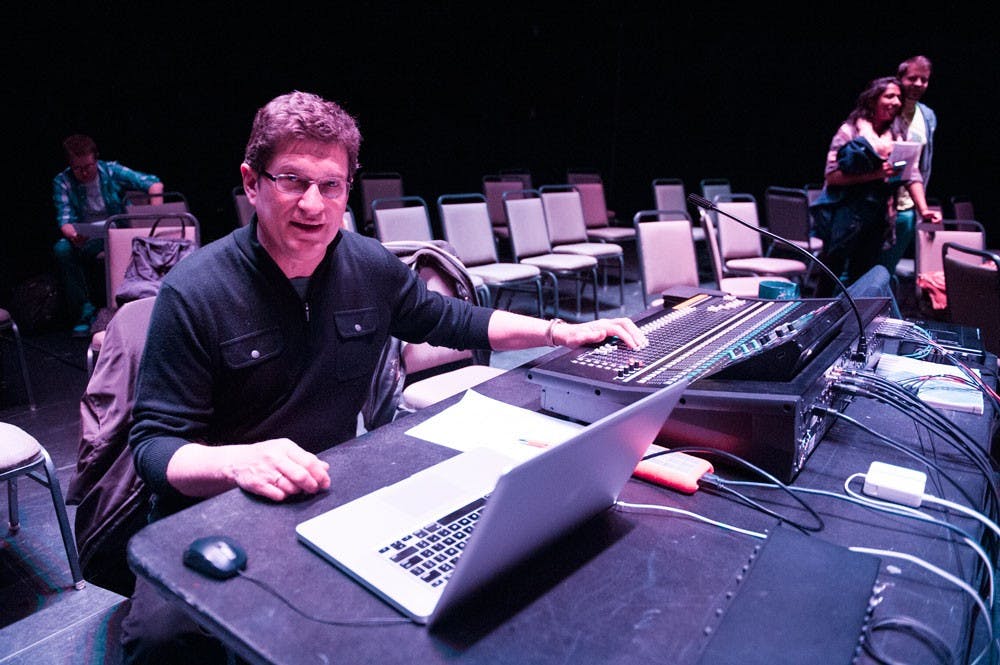In the Center for the Art’s small, underground Black Box Theater, with barely enough light to see the person next to you, the music department held an experimental electronic concert for an audience of about 85 people.
The annual Black Box Concert, presented this year by The Hiller Computer Music Studios of the Department of Music, showcased six performers, ranging from UB graduates, current faculty and other artists invited to perform various soundscapes centered on the manipulation of four-channel media and sound mixing.
Every year, organizers select a different electro acoustic focus; this year, they chose fixed-media pieces.
Ethan Hayden, who helped organize the concert and recently graduated from UB with an M.A. in composition, described fixed-media pieces as “pre-recorded music playing back over the speakers. It does not change like a pianist’s concert would, it is locked into place.”
Hayden said the Black Box Concert has been around since the ’90s. The concert allows untraditional musicians to showcase their works, which may not receive recognition otherwise, he said.
The evening started off with Cory Lippe, a UB professor in the music department who helped organize the concert, playing his composition named “Avocean.” Lippe composed the piece at SYCOM (Systems Complex for the Performing Arts) in 1972.
The piece is comprised of a series of frequency and amplitude modulation in slowly altering sequences. His minimalist soundscape pulsated around the room in electronic waves, a digital heartbeat of oscillating beeps and a pervasive, constant drone of sequenced MIDI (Musical Instrument Digital Interface) effects.
Four-channel recording is unlike any mainstream music on the radio, as it has no instruments or dominating time signature and instead uses using small, repeating sound bytes and snippets.
In addition, the visually barren atmosphere – the audience sat in the dark during most of the performances – helped to emphasize the esoteric soundscape.
Allen Hoste, a freshman pharmacology and toxicology student, described the concert’s overall aesthetic as a “a complete sensory performance.”
“The lighting and surround sound … added a chilling aspect to the music that gave it such an experimental vibe,” Hoste said.
This manipulation of spatial and sonic qualities was the emphasis of the concert, according to Lippe.
When deciding the location of the concert, Lippe said, “spatial location of sound becomes a significant musical parameter with electronic music.”
All of the pieces focus primarily on the timbre of the music, rather than the melody, harmony or rhythm, according to Lippe.
As the night progressed, the performers’ punctuating electronic sounds echoed around the room. The audience sat in silence for the majority of the evening, breaking the stillness only to applaud the musicians after each performance.
Derek Wang, a freshman biomedical engineering student, attended the concert as an optional activity for Lippe’s MUS114 class.
“Instead of your typical notes, temp and pitches being played like in classical music, experimental electric music sounds like organized noise,” Wang said.
The abstraction of the music, both in composition and performance, is one of the joys of this musical genre, according to many of the performers.
Gayle Young was invited to perform her piece “Wavelength One.” The piece was one of the only performances lit-up on stage.
In “Wavelength One,” Young illustrated the abstract nature of the art form as she used two violin bows to play an amaranth, an instrument of her own design shaped like a log with violin strings on top, while a pre-recording of waves played in the background creating a delicately balanced piece.
After the show, Young said her performance was largely improvised – her only pre-show objective was to match the sound of the waves with her instrument onstage.
For Young, artistry is being able to accept the subjectivity of art.
“Listeners often come up with their own responses and sometimes they are very different from each other,” Young said. “A musician or composer has to accept that. I would hope that listeners have a sense of engagement with the sound – put very simply, that they get involved, imaginatively, and are stimulated by listening.”
The audience warmly received all of the participants in the Black Box concert. No one, however, was applauded more loudly than the final performer of the night, Ethan Hayden.
Hayden performed the last piece of the night, “…ce dangereux supplement.” The piece was primarily driven by Hayden’s experimental vocalizations.
Adam Cole, a freshman biomedical engineering student, said the concert, overall, was “too strange” for him to enjoy, but couldn’t help but watch Hayden’s performance.
The piece, which lasted about 15 minutes, featured Hayden standing center stage beat boxing, shrieking odd syllables and warbling.
Hayden’s eccentric, but memorable performance capped off the evening.
The concert, unlike any other sonic or sensory experience in mainstream music circles was, above all else, an exercise in mental flexibility.
To fully appreciate this sonically strange experience, listeners were forced to set aside any preconceptions about what music is, how music is made and how to listen to music, according to Lippe.
“[This music] requires an open mind, and an openness to listening in other ways,” Lippe said. “Too much music is listened to as background sound: while walking, watching YouTube, meeting friends, shopping in the mall, we are inundated with music. Listening to music in a concentrated fashion without distractions is becoming rarer and rarer as music becomes the backdrop to everything we do.”
Brian Windschitl is an arts editor and can be contacted at brian.windschitl@ubspectrum.com





